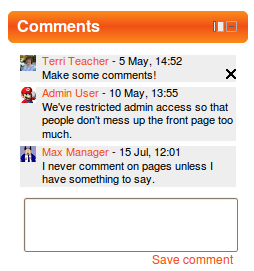Comments: Difference between revisions
Tomaz Lasic (talk | contribs) m (moved Comments 2.0 to Comments: Losing the 2.0 extension.) |
Tomaz Lasic (talk | contribs) No edit summary |
||
| Line 1: | Line 1: | ||
{{ | {{Comments}} | ||
<p class="note">'''Please refer to [[Page_notes#Comments|these notes]] before editing this page.'''</p> | |||
[[Image:Comments block.png|frame|Comments block|left]]In Moodle 2.0 onwards, a new [[Comments block|comments block]] can be added to any page in Moodle, enabling users to easily add comments. A similar interface enables comments to be added to glossary, database activity and blog entries. Comments can be disabled/enabled in Site Administration>[[Advanced_features]]. | [[Image:Comments block.png|frame|Comments block|left]]In Moodle 2.0 onwards, a new [[Comments block|comments block]] can be added to any page in Moodle, enabling users to easily add comments. A similar interface enables comments to be added to glossary, database activity and blog entries. Comments can be disabled/enabled in Site Administration>[[Advanced_features]]. | ||
Revision as of 03:31, 10 June 2011
Please refer to these notes before editing this page.
In Moodle 2.0 onwards, a new comments block can be added to any page in Moodle, enabling users to easily add comments. A similar interface enables comments to be added to glossary, database activity and blog entries. Comments can be disabled/enabled in Site Administration>Advanced_features.
The comments interface uses AJAX so that comments are added instantly without needing a page refresh.
Blog comments
Blog comments are enabled by default. The feature may be disabled in Site administration > Appearance > Blog.
Comments report
A list of all comments added may be found in Site administration > Reports > Comments.
See also
- Development:Comments 2.0
- MDL-23605 (Dis)allowing users to create Comments block on their profile
